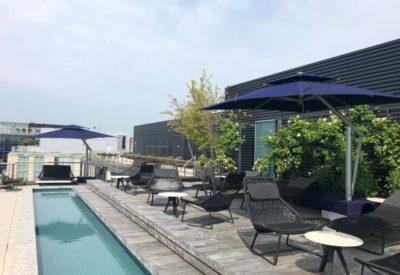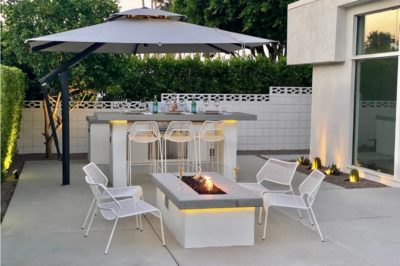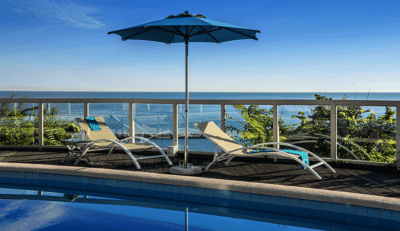Top Tips for Choosing the Best Outdoor Umbrella

Different kinds of outdoor umbrellas offer various features and benefits. Along with shade and privacy, an outdoor umbrella can also add a pop of color to your backyard décor while helping define your outdoor seating area. There are many types of patio umbrellas available, including deck umbrellas, table umbrellas, and cantilever umbrellas, and they all come in various materials, styles, and colors. Aluminium umbrellas, however, are far more durable and recommended for commercial clients. Here is a quick guide with some expert tips to help you choose the best outdoor umbrella for your home.
Choose an umbrella style that suits your needs
Outdoor umbrella canopies are either round, octagonal, or rectangular and can come in weather- and UV-resistant materials with various colors and patterns. Patio umbrellas typically have a pulley or a crank mechanism to open and close, or they can be pushed up to open and held in place with a pin or can have push buttons to open. For ease of use, many patio umbrellas now use a crank mechanism that locks in place. This crank can open and close the umbrella and sometimes even tilt the umbrella. Patio umbrellas come in two general types—center pole and offset. It is recommended to choose an aluminium umbrella for outdoor purposes.
Centre pole umbrellas:
These umbrellas have a straight pole extending from a secure base to the top of the canopy. They may have a fixed base or a mobile base with wheels and may be used in the center of tables with holes. While center pole umbrellas offer excellent protection against direct sunlight, they may not provide sufficient protection against diffuse or reflected UV radiation coming from the sides of the umbrella. Here is a look at some of the various styles of center pole umbrellas:
- Sunshades: a round disc on a pole, large enough to shade one person, usually near individual chaise lounges;
- Market: round or octagonal umbrellas, often with vented tops to cool the area and withstand strong winds;
- Pagoda: parasol-style, Asian-inspired umbrellas with a Japanese pagoda-style shape;
- Half umbrellas: have canopies with one flat side to sit flush against a wall, like a portable awning, and straight or rounded edges with or without drapes or valances. These are ideal for porches, balconies, and other small outdoor spaces.
Cantilever umbrellas:
Offset umbrellas, also known as cantilever umbrellas, sit beside a table or seating area with the umbrella base out of the way. These outdoor umbrellas have an arched or jointed pole positioned off to one side, supporting the canopy hanging over tables and seating areas. Cantilever umbrellas often have heavier bases than center pole umbrellas to support the overhanging canopy, and they can shade larger areas without obstructing your patio space. Most types can also rotate to provide 360˚ coverage. These umbrellas are ideal for shading patio tables without umbrella holes, small tables, small spaces (since the base stays out of the way), lounge chairs (e.g., by the pool), and deep-seating sets. Cantilever umbrellas do not get in the way and can be adjusted as the sun moves so you can have ample shade throughout the day.

Determine the umbrella size required
The size of your outdoor umbrella should be the right fit for the space available and the purpose it will serve. Consider the rule of thumb that your umbrella should have a diameter of 5 feet larger than the area it is intended to cover. If you choose an oversized umbrella, it could overwhelm or throw off the balance of your outdoor space layout. For proper shade space, the umbrella should extend over your dining table by 2 feet on each side to provide optimal comfort. For instance, if you have a 4-foot round table, you will need an umbrella that measures 8 feet in diameter. Remember that extra shade will allow you to have a fuller glare-free experience depending on where the sun is and even provide a bigger space for kids to play in without having to worry about sun exposure. Be sure to keep in mind that your umbrella should be at least 7 to 9 feet tall, no matter which area it will be placed in. Get your tape and measure the space that your patio umbrella will need to shade.

Find the best material and color for your umbrella
The best canopy materials are fabrics that will not fade from UV rays, such as Sunbrella acrylic UV- and weather-resistant fabrics. These fabrics, along with olefin, are easy to wipe clean and are resistant to mold and mildew. Canopies with colors, stripes, and patterns look better for longer compared to white fabrics, which tend to show dirt and age. For an umbrella that will not fade in the sun, you will want one made from canvas or vinyl. To save some money, go with a polyester umbrella. It is almost as durable as Sunbrella and is similarly resistant to fading, mold, and holes or tears.
For umbrella frames, consider durable materials that will not break easily, such as aluminum and fiberglass. If you want to go with wood, choose a wood that will age well, is weather-resistant (e.g., bamboo or teak), and is treated to resist insects, decay, and weather damage. Stainless steel and aluminum patio umbrellas have a sleek, modern vibe that complements minimalist décor and wide, open spaces. Aluminum umbrella frames are lightweight and durable enough to resist breakage from strong winds, and with an anodized or powder-coated finish, aluminum frames can resist rust and damage from harsh weather conditions. These frames are also available in different finishes to suit various outdoor décors. Fiberglass umbrellas are lightweight, weather- and rust-resistant, and their flexibility makes these umbrellas the most resistant to breakage from strong winds. Fiberglass umbrellas are available in various colors, which helps them blend into any outdoor color palette. Many modern patio umbrellas pair fiberglass ribs with aluminum poles to reap the benefits of both materials.
A well-designed outdoor umbrella can keep you comfortable and protected from the sun while keeping your outdoor living space looking great for many years to come. To find the right umbrella for you, consider this guide, and if you want some guidance from an umbrella expert, turn to Poggesi for assistance in choosing the best outdoor umbrella for your residential shading needs.